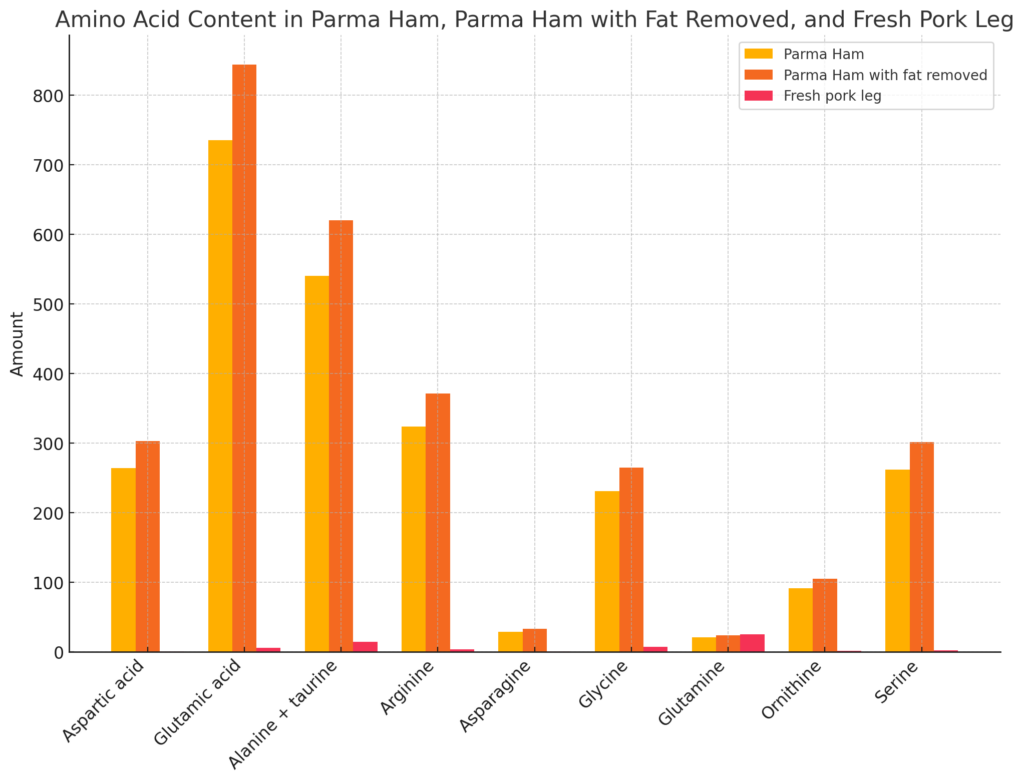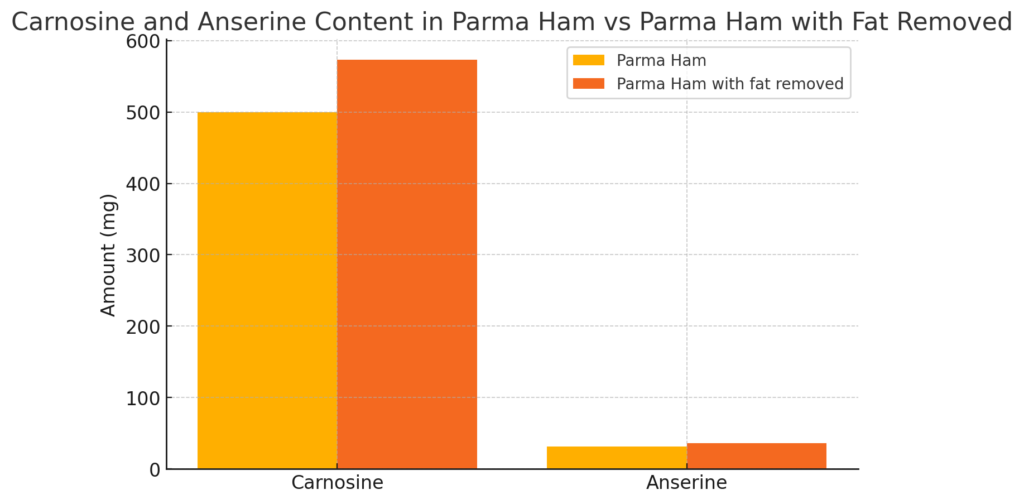
Parma Ham, a renowned Italian delicacy, is often enjoyed for its unique flavor and texture. However, beyond its taste, it’s interesting to explore its nutritional content, especially when comparing the regular version with the fat-removed variant. In this article, we will delve into the nutritional differences between Parma Ham and Parma Ham with the outer fat removed, examining their content in terms of amino acids, fatty acids, vitamins, minerals, and specific bioactive compounds.
Amino Acid Content

Amino acids are the building blocks of proteins, essential for numerous physiological functions. When comparing Parma Ham with its fat-removed counterpart, it is evident that both versions are rich in essential and non-essential amino acids. The bar charts reveal that the fat-removed version generally has higher amino acid content across the board. For instance, the levels of leucine, lysine, and glutamic acid are notably higher in the fat-removed version, which could suggest that removing the fat might concentrate the amino acids, enhancing the ham’s nutritional value in this regard.
Fatty Acid Composition

The fatty acid profile of Parma Ham provides insight into its lipid content, particularly the balance between saturated and unsaturated fats. As visualized in the horizontal bar chart, oleic acid (C18:1) constitutes the majority of the fatty acids, representing approximately 45.8% of the total. This monounsaturated fat is known for its beneficial effects on heart health. Other significant fatty acids include palmitic acid (C16:0), a saturated fat, and linoleic acid (C18:2), a polyunsaturated fat. The presence of these fats in Parma Ham underscores its complex lipid profile, which contributes to its rich taste and texture.
Vitamin Content

Vitamins are critical for maintaining health, and Parma Ham is a source of several important ones. The bar chart comparison between the regular and fat-removed versions shows that the latter has slightly higher levels of most vitamins. Vitamin B1 (thiamine), Vitamin B6 (pyridoxine), and Vitamin B9 (folates) are particularly abundant, especially in the fat-removed variant. This increase might be attributed to the concentration effect after fat removal. However, it’s worth noting that Vitamin E (tocopherol), a fat-soluble vitamin, remains unchanged, highlighting that the fat content does not significantly affect its concentration.
Mineral Content

Minerals play a crucial role in various bodily functions, and Parma Ham provides a range of these essential nutrients. The comparison of mineral content reveals that the fat-removed version contains higher levels of most minerals, particularly potassium, sodium, and phosphorus. Sodium, which is considerably high in both versions, is expected due to the curing process involved in making Parma Ham. While high sodium levels can be a concern for those monitoring their intake, the presence of other minerals like potassium and magnesium helps balance some of the potential adverse effects.
Carnosine and Anserine Content

Carnosine and anserine are bioactive compounds known for their antioxidant properties and role in muscle function. The final bar chart demonstrates that Parma Ham with fat removed has higher concentrations of both compounds compared to the regular version. Carnosine, in particular, is present at over 570 mg in the fat-removed variant, making it a notable source of this beneficial compound. Anserine, though present in smaller amounts, also shows an increase in the fat-removed ham.
Conclusion
The comparative analysis of Parma Ham and its fat-removed variant reveals that removing the outer fat can lead to a concentration of many beneficial nutrients, including amino acids, vitamins, and minerals. While the regular Parma Ham is already a nutritious option, those looking for slightly higher nutrient density might opt for the fat-removed version. However, the choice between the two should ultimately depend on individual dietary needs and preferences, as both offer distinct benefits and contribute to a well-rounded diet.
探索更多來自 Emilia Delizia 的內容
訂閱即可透過電子郵件收到最新文章。